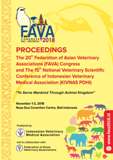SA-8 Non-Surgical Treatment of Unilateral Cherry Eye in Shih-Tzu Puppies
Abstract
Prolaps of third eyelid gland is a disease of young dogs, from 4 weeks to 2 years of age. Prolaps of the gland may appear as a red mass in the medial canthus. The prolaps is sudden in onset but it may regress once or twice for a few days and finally returns to remain for the animal’s life. Certain breeds such as the American Cocker Spaniel, English Bulldog, Boston Terrier, Lhasa Apso, Shih-Tzu, Beagle, and Pekingese are more prone to develop the condition. The etiology is unknown, and there is disagreement as to whether inflammation predisposes the animal to prolapsed [1]. Prolapse of the nictitans gland mainly seen in the dog, unilateral or more frequently bilateral, and usually one eye following the others, often in young dog including puppies, and known as “cherry eye” [2]. A thorough, relevant history is an important part of the diagnostic process. To use the problem-oriented approach, the clinician first determines the major problems that have caused the owner to present the animal for examination. An ophthalmic examination requires a minimum of equipment (Focal light source, Magnifying loupes, Direct ophthalmoscope, Indirect funduscopic lens, Schirmer tear test strips, Fluorescein test strips, Tonometer, Tropicamide (1%), Proparacaine / topical anesthetic, Sterile eye wash/rinse) [3]. Initial treatment with a topical antibiotic/steroid preparation may appear transiently to cause the gland to become replaced. Although not recommended by veterinary ophthalmologists, excision of the gland is still widely practiced by the general practioner [1].

